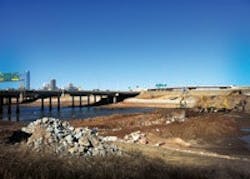Going Under the Oklahoma River
Oklahoma City is the most populated city in the state of Oklahoma and the 29th largest city in the U.S. At 621.2 sq miles, it is in the top five largest cities in the country in terms of geographic area and spreads into four counties: Oklahoma, Canadian, Cleveland and Pottawatomie. Consisting of more than 1.2 million people, this region is Oklahoma’s largest metropolitan area.
For many Oklahoma City residents, the waterway now known as the Oklahoma River was long thought of as little more than a drainage ditch. In 2004, a 7-mile stretch of the North Canadian River that flows just south of downtown was transformed as part of the original Metropolitan Area Projects initiatives. The $54-million development included dams to raise the water levels—which created river lakes for recreation—recreational trails and more and was renamed the “Oklahoma River.”
The $6-million Oklahoma River Inverted Siphon System Improvements, Phase II project included the potential rehabilitation of an existing three-barrel inverted siphon, new inverted siphon, a sewer flow distribution vault and a sewer line connecting the new inverted siphon to the collection system. This project increased the city’s capacity to transport sewage from south Oklahoma City to the North Canadian Wastewater Treatment Plant. The existing siphon had inadequate capacity to handle flows during wet weather events. The project was developed to help reduce sanitary sewer overflows in the Brock Creek and Lightning Creek sewersheds.
Field Versatility
The new inverted siphon was installed under the Oklahoma River with 587 ft of 24-in. fiberglass pipe and 587 ft of 48-in. fiberglass pipe. Inverted siphons allow storm water or wastewater sewers to pass under obstructions such as rivers.
In addition, 2,500 ft of 72-in. sanitary sewer main were installed by direct bury. Hobas Pipe USA was the pipe supplier for Phase II; the company custom manufactured centrifugally cast, fiberglass-reinforced, polymer mortar (CCFRPM) pipe for this project.
Instead of continuing with the 72-in. pipe into the siphon, the dual line was preferred. “The smaller pipes generate flow velocities high enough to scour sludge buildup,” said E. O’Neil Robinson, P.E., associate for Cardinal Eng. “The 72-in. pipe velocities are fine for the normal grades, but at the siphon, the velocities would drop, causing solids to drop out and block the flow.”
Ease of Installation
The schedule for the siphon installation was time-sensitive due to the activity on the Oklahoma River. This particular section of the river is the site of the Oklahoma City Boathouse District, which includes rowing clubs. “We only had about 60 days to construct the new siphons,” Robinson said. “Because we had to lower the water level for construction, we had an agreement with the city that the water level would be raised to the appropriate level for the planned rowing events.” It was built into the contract that the installation contractor would receive a bonus of $100,000 for completing this section by the requested due date.
Lewis Contractors of Georgetown, Texas, was the installation contractor for the project and received the bonus for completing it by the due date despite a four-week rain delay. With the water level lowered by the dams and controlled by a dewatering process, the siphons were installed. A challenge of the siphon installation was the soil conditions.
“The biggest challenge of the siphon installation was the depth. In some areas, we were 30 ft deep to rock; soil conditions were sand and water. It was a challenge to shore the area and keep the trench dry,” said Bill Geiser, North Texas area manager for Lewis Contractors Inc.
As the pipe was laid and joints connected, it was encased in reinforced concrete to prevent floatation and covered with 18-in. riprap. This section of the river is periodically dredged, so the concrete would act as a barrier in case contact was made with the dredging equipment.
Forty-five-degree CCFRPM elbows were manufactured and designed to take the flow from the 72-in. line into the smaller siphons and feed it into the 72-in. line on the other side of the river via inlet and outlet structures.
Construction Benefits
“We choose to specify CCFRPM in the design because we felt very comfortable using the product. It was the appropriate product for this project due to the construction technique chosen and the time constraints imposed,” Robinson said. The pipe’s light weight led to a faster installation due to the ease of handling and limiting of heavy equipment.
“Access to the north side of the river with equipment and materials was difficult, as it is confined by two major highways, Interstate 35 and Interstate 40. We worked with the Oklahoma Department of Transportation (ODOT) to develop a plan,” Robinson said. Temporary access was proposed to coordinate entry and exit from Interstate 40 right-of-way with ODOT.
In addition to the added capacity, the new siphon will allow for easier and safer maintenance of either the existing or new siphon. The existing siphon, constructed of 24-, 30- and 42-in. pipe, will be cleaned and inspected to determine if it needs to be rehabilitated.
The 72-in. direct-bury portion was 25 to 30 ft deep. “Coarse sand and groundwater were about 10 ft above the pipe. We had to encase the CCFRPM pipe in flow fill to prevent floatation,” Geiser said. The majority of the project is complete and expected to be in service by the end of the year.
Download: Here
